A New Ancient Crystal Skull Discovered!
- Details
- Written by AndEl
The Mitchell-Hedges Crystal Skull is no longer unique! Out of Africa – by way of California – emerges another ancient skull, “Compassion”, with a detachable jaw. Already, this skull is re-carving the crystal skull landscape!
Philip Coppens
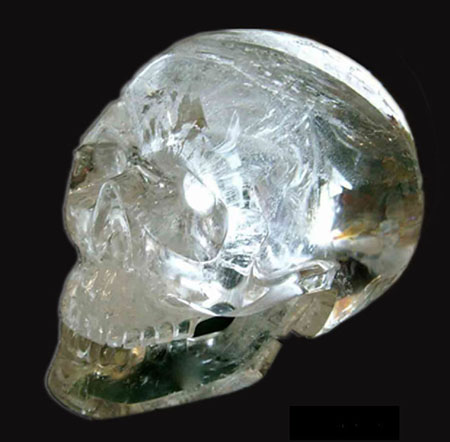 With the 2008 release of “Indiana Jones and the Kingdom of the Crystal Skull”, crystal skulls attained a far higher level of exposure than ever before. Before, crystal skulls had only become somewhat famous in the 1980s, particularly in New Age circles. Today, there are hundreds of crystal skulls, almost all of them of modern fabrication (most made in China) and used in various New Age-type seminars. Only a handful of skulls are suspected of having ancient origins, including the most famous of all crystal skulls: the Mitchell-Hedges crystal skull.
With the 2008 release of “Indiana Jones and the Kingdom of the Crystal Skull”, crystal skulls attained a far higher level of exposure than ever before. Before, crystal skulls had only become somewhat famous in the 1980s, particularly in New Age circles. Today, there are hundreds of crystal skulls, almost all of them of modern fabrication (most made in China) and used in various New Age-type seminars. Only a handful of skulls are suspected of having ancient origins, including the most famous of all crystal skulls: the Mitchell-Hedges crystal skull.
“Indiana Jones and the Kingdom of the Crystal Skull” makes scant references to the Mitchell-Hedges crystal skull. It stands out for it is by far the most complex, and the only skull with a detachable jaw, meaning that whomever made this, was a master artist in carving crystal – able to create a feat that modern carvers have been unable to accomplish. Gerald Leandro De Souza, a master skull carver from Brazil with 25 years of experience behind him, notes that “the process of cutting the jaw from a skull causes the jaw to break and is almost impossible for skull carvers to accomplish.”
Still, sceptics, principally led by Jane Walsh, an anthropologist at the Smithsonian National Museum of Natural History, try to argue that all these skulls are of modern fabrications. So far, none of the claims made by Walsh and co. have been substantiated, let alone supported by factual evidence. Specifically, Walsh tries to point the finger to Germany and the town of Idar-Oberstein, arguing most of these skulls were carved there by the resident artists. However, no records of skull carving have ever been found there; there are no records of any carver doing carving in the middle of the 19th century, when some of these skulls are said to have been made. In short, Walsh’s theories remain totally unsubstantiated – not very scientific!
On the other side of the debate are the likes of Nick Nocerino, one of the first crystal skull researchers, who travelled extensively throughout Central America, in search of them. He noted how on several occasions, Indian tribes offered skulls on sale to him, as with the money, the local shamans could buy precious Western medicine and like, to help their tribe at a time when the Mayan people were subjected to genocide. Nocerino always refused such offers, as he strongly believed the skulls were such an integral part of Mayan society, that these tribes needed their precious talisman. (Though he did everything to help the tribes in other ways.)
The Mitchell-Hedges crystal skull too comes with a Central American origin. The family itself stated that Anna Mitchell-Hedges found the skull in the ruins of Lubaantuun on her 17th birthday in 1924. It is a story Anna adhered to until her death, though it was subjected to intense criticism from the sceptics. Indeed, a more likely story about how her father found the skull is told in his novel, “The White Tiger”, published in 1931. In it, he relates a largely autobiographical account of an Englishman who is initiated by a Mayan tribe, to become the principal caretaker of a most important treasure. When the Mayan priest shows him the treasure, the Englishman is led down into a series of tunnels, before the treasure is unveiled to him: “Before him, piled in endless confusion, lay the treasure of the Aztecs. Gold chalices, bowls, jars and other vessels of every size and shape; immense plaques and strange ornaments all glittered dully. Of precious stones there were none, but many rare chalchihuitl (jadeite pendants) [sic]. Masks of obsidian and shells beautifully inlaid were all heaped together with heads carved from solid blocks of crystal. Legend had not exaggerated the treasure of the Aztecs. Almost boundless wealth lay at the disposal of the White Tiger.”
“Heads carved from solid blocks of crystals”: a reference to crystal skulls made by Frederick “Mike” Mitchell-Hedges in 1931, more than a decade before he – according to the likes of Walsh – acquired a skull at auction at Sotheby’s in London in 1943.
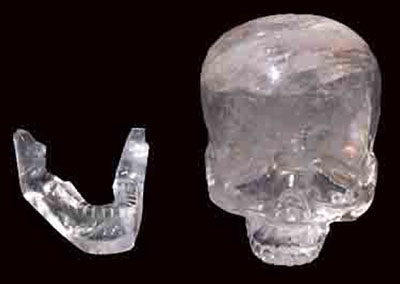 Because it is the most complex, the Mitchell-Hedges crystal skull is both the most famous and the most debated. It is unique. But today, the Mitchell-Hedges skull is no longer unique: on August 6, 2009, former Alaskan fisherman Joe Bennett was able to finally buy, from a Californian import shop, a crystal skull… with a detachable jaw, which he soon named “Compassion”. A new era in crystal skull research had therefore dawned, for a number of reasons.
Because it is the most complex, the Mitchell-Hedges crystal skull is both the most famous and the most debated. It is unique. But today, the Mitchell-Hedges skull is no longer unique: on August 6, 2009, former Alaskan fisherman Joe Bennett was able to finally buy, from a Californian import shop, a crystal skull… with a detachable jaw, which he soon named “Compassion”. A new era in crystal skull research had therefore dawned, for a number of reasons.
Bennett is a retired fisherman from Alaska. He had earned the nickname “the crystal sailor”, as for years, he had been collecting an impressive array of crystals. In his hunt for crystals, in 2006, he stumbled upon a crystal skull, in an import store in Carmel, California. The skull had belonged to a close friend of the owners, who had brought it over from Africa. Upon his death his family liquidated the estate and asked the import store to sell the crystal skull for them.
Bennett relates how he “noticed a crystal skull in the back of this shop on a high shelf. I admired the extreme craftsmanship, saw the price and forgot about it. Like most people I didn’t have any reference for crystal skulls other than Halloween witches or Black Magic.” However, the skull did not let go of Joe, who had a series of vivid dreams about the skull, so much so that he dispatched his sister – who lived nearby – to make a series of photographs, which she sent to Joe. It was now only a matter of time before the skull would end up in Bennett’s care.
Compassion is human-sized and clear quartz, 5.5” tall, 5.5” wide and 8 inches long, weighing 11 pounds – very similar in dimensions to the Mitchell-Hedges skull. The mouth has 28 teeth. Little is known of the origins of the skull. It is known that the skull was in storage in the United States for five years prior to the shop putting it up for sale. Before, it had spent 22 years in a warehouse in Africa. The name of the people who owned it in Africa is not a matter of public record, but initial analyses of the skull have shown that the crystal is not from Brazil. Gerald Leandro De Souza argues that the “quartz probably is from Africa”. The likeliest source is Namibia, Africa, which is a well-known location where quartz crystal can be found.
Whereas the Mitchell-Hedges skull is “crystal clear”, Compassion is more like another crystal skull, known as MAX: Compassion is made out of three distinct layers (MAX has five such layers). The largest, frontal part is made of the clearest quartz crystal. Behind, roughly the top of the forehead, is a somewhat softer section of less-clear crystal. Behind is a final, third layer, separated from the others by a small fissure of iron oxide, which one can only truly see from the back of the skull.
The possibility that the material inside the fissure is iron oxide was first suggested by crystal carver James Ziegler, who added that the material at the bottom of the fissure was feldspar. This conclusion was confirmed when Bennett had the skull examined by Dr. Ray Corbett, Associate Curator of Archaeology at the Natural History Museum in Santa Barbara and Geologist Dr. John Minch on March 30, 2010. It was Minch who confirmed that the fissure was filled with iron oxide.
These experts furthermore accepted that the grounding of the crystal had occurred by hand, and not by machine. One area of the skull show pie-shaped areas, which a carver would keep, but a grinding wheel would smooth out. There are other aspects of the skull, especially to do with a lack of symmetry between the right and left side, which show that the work was carried out by human hands. Corbett and Minch also identified that the natural growth of the crystal is for the skull to be placed with the teeth pointing up. This means that the iron oxide layer was at the bottom of the then axis of the crystal, with the layer of the face being the clearest and the top one. The carver would have to carve against the grain of the skull and skip over these fractures, a task which crystal carvers say is extremely hard to do – surpassing their expertise.
When one runs a fingernail along the top of the skull, one can feel the fractures between the layers. Dr. Minch said that whoever made this skull, would have to do so very slowly, for if the quartz were to get hot, it would shatter – thus underlining that the usage of tools in the making of this skull was unlikely.
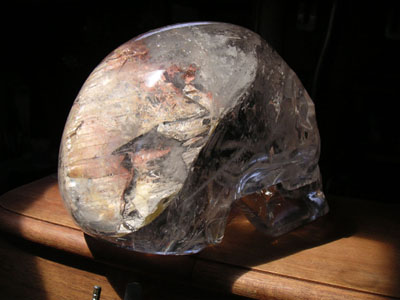 During testing, Dr. Minch also noted there was an “air bubble” inside the skull. When the skull is rocked, the bubble moves over half the thickness (about 1mm) up and down in a solution which he believes is water, which somehow made its way into the skull and trapped the air bubble inside. Bennett has speculated whether this air bubble should be interpreted as a representation of the pineal gland, a part of the brain that is often referred to as the “third eye”, and which is therefore heavily imbued with esoteric meaning. René Descartes even labelled it the seat of the soul, echoing a belief that goes back thousands of years.
During testing, Dr. Minch also noted there was an “air bubble” inside the skull. When the skull is rocked, the bubble moves over half the thickness (about 1mm) up and down in a solution which he believes is water, which somehow made its way into the skull and trapped the air bubble inside. Bennett has speculated whether this air bubble should be interpreted as a representation of the pineal gland, a part of the brain that is often referred to as the “third eye”, and which is therefore heavily imbued with esoteric meaning. René Descartes even labelled it the seat of the soul, echoing a belief that goes back thousands of years.
Minch also found golden rutile in both skull and jaw. Rutile is a major ore of titanium, and is found as microscopic inclusions in quartz and other precious gemstones. It is responsible for many of the light effects that one sees within these objects.
Scientists have a hard time admitting that the detachable jaw of the Mitchell-Hedges crystal skull is made from crystal (it is), and is from the same crystal as the rest of the skull (it is). But no such doubt can arise in the case of Compassion: its right cheek has a foil in the crystal that runs from the right cheek into jaw, and hence clearly shows that both the main part of the skull and the jaw are from the same crystal.
It will be interesting to see what sceptics are now going to do. In the case of the Mitchell-Hedges crystal skull, they tried to debate the jaw away, as the creation of such a jaw has never been accomplished by modern crystal workers. But Compassion will not look compassionately upon these sceptics, who will have to come up with stronger arguments, if they want to persist in continuing the same old controversies in trying to explain away what is one of the most interesting recent discoveries.
However impressive Compassion is, its face is not symmetrical. With its detachable jaw placed underneath the skull’s teeth, Compassion looks and is symmetrical, but remove the jaw, and it becomes clear that the skull is off-centre: the teeth are slanted to the right. The only place where polishing marks are evident to the human eye is under the maxilla. This area was not finely polished, maybe to illustrate it was hand carved. The rest of the skull does not show any of these marks. Indeed, Compassion brings us to an interesting conclusion: the skull is clearly made by human hands, but whomever made it, had an expertise in working with quartz crystal, which exceeds that of anyone alive today. In short, there is an entire lost science of working with quartz crystal. But where did it come from, and where did it go?
Finally, when we stare into its eyes, it is clear that both are not identical: the left eye is far clearer than the right. It was in fact while Bennett and his wife stared into the skull’s eyes, that they felt “it” looked sad. His wife said she “showed compassion in her gaze” and a name was born. Both also felt that Compassion held a feminine energy.
Bennett has photographed the skull extensively. Some of the close-ups have revealed a number of interesting subliminal images that Compassion conjures up. When the skull was placed on a light-box, one such image that emerged was of an enigmatic head, while nearby, there was the outline of a horse’s head.
The key question is whether Compassion can ever be proven to be ancient. As mentioned, the likes of Jane Walsh from the Smithsonian have gone out of their way – abandoning the scientific process altogether – to argue come what may that all skulls are of modern origin. Their scientific bias was apparent during the testing of the Mitchell-Hedges crystal skull in 2008, when one member of the team straightforwardly proclaimed that the detachable jaw clearly was and could only be glass. When it was found out not to be glass soon afterwards, he exclaimed somewhat reservedly “this did not mean it was crystal” – even though previous testing by Hewlett-Packard had clearly shown that the jaw was indeed crystal!
The problem is that crystal is impossible to date, so any dating needs to happen through other, secondary means. Evidence of tools, especially the wheel, has been put forward as the key indicator as to whether a skull is ancient (read: pre-Columbian) or modern. However much this argument is flawed, it cannot apply to a skull that comes from Africa – Africa was never an isolated continent, witnessing the origins of Mankind several tens of thousands of years ago. The argument only works if we see crystal skulls as a purely American phenomenon, whereby the wheel is assumed to have been introduced with the arrival of Western Europeans.
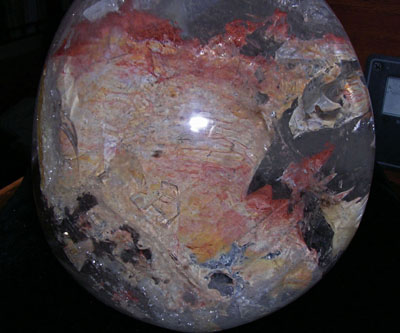 Of course, the skull’s presence in Africa for a number of decades does not mean it was always there. Equally, the origins of civilisation in Central America itself remains enigmatic. The Olmec civilisation dates back to at least 1200 BC, and some have argued for an African origin to this civilisation. In 1972, Dr. A. Wiercinski argued that some of the Olmecs were of African origin, supporting his claim with skeletal evidence from several Olmec sites. According to Clyde Winters, the Olmecs were from the Mandinka region of West Africa (north of Namibia). Their language is known as Mende, the script which was actually found on monuments at Monte Alban in Mexico. Interestingly, it is at Monte Alban that evidence has been found that the Mayans were definitely familiar with crystal artefacts.
Of course, the skull’s presence in Africa for a number of decades does not mean it was always there. Equally, the origins of civilisation in Central America itself remains enigmatic. The Olmec civilisation dates back to at least 1200 BC, and some have argued for an African origin to this civilisation. In 1972, Dr. A. Wiercinski argued that some of the Olmecs were of African origin, supporting his claim with skeletal evidence from several Olmec sites. According to Clyde Winters, the Olmecs were from the Mandinka region of West Africa (north of Namibia). Their language is known as Mende, the script which was actually found on monuments at Monte Alban in Mexico. Interestingly, it is at Monte Alban that evidence has been found that the Mayans were definitely familiar with crystal artefacts.
Still, the quartz crystal itself having Namibia as its likeliest origin means that the skull itself must have had an African connection, wherever it was carved or used. And whereas there are Mayan legends of how skulls with removable jaws could “sing and talk” during certain religious ceremonies that were performed in the many Mayan sanctuaries, the question is which African cultures held crystal skulls dear.
Little is known about Compassion and seeing its existence is only known about for a year, most discoveries about it are still to come. If we were to assume that it is indeed of African origins, then we are confronted with crystal skulls on both sides of the Atlantic Ocean, bearing great similarities. Are they evidence of pre-Columbian contact between the two continents, in which case the Olmecs are the likeliest candidate, or should we look at much older origins, including the fabled lost civilisation of Atlantis?
Those who have communicated with the skulls – in trance, meditation or otherwise – keep referring to an Atlantean connection. During a crystal skull conference in September 2009 – one of the first public airings of Compassion – Mayan elder Hunbatz Men was one of the speakers and he became intrigued by Compassion. Studying the skull closely, he exclaimed “Atlantis!” He added that there was a matrix in the back of the skull which showed an ancient map which he did not understand. Several months later, Bennett realised that the iron oxide layer in the skull largely resembles a map of the African continent. Coincidence, or not?
Another psychic who has worked with Compassion is Carole Wilson/Davis. Wilson originally worked with the Mitchell-Hedges skull, resulting in “The Skull Speaks”, published in 1985 and one of the first books to appear on crystal skulls altogether. For Wilson, the iron oxide came in the shape of a phoenix, spreading its wings, with a head and a beak in the centre. She added that the information from Compassion changed, whereas that of the Mitchell-Hedges was stable – “the same information every day.”
Within Mayan creation mythology, there is a special role for skulls. Ancient temple complexes like Chichen Itza are three-dimensional renderings of the Mayan creation myth. Near the famous pyramid and ball court is an unimpressive “Platform of the Skull”. In the creation myth, when playing ball, the Twin Maize Gods disturbed the lords of Xibalba, the Mayan underworld. The Xibalbans summoned the Maize Gods to the underworld to answer for their disrespectful behaviour. There, they subjected them to a series of trials. When they failed these tests, they were killed and buried in the ball court of Xibalba. The eldest twin was decapitated, his head hung in the tree next to the ball court, as a warning to anyone who might repeat their offence. This was visualised on the Platform of the Skull. There is no archaeological evidence as to what type of skull hung there, but seeing it was a divine skull, which spoke and spat, a crystal skull with a detachable jaw would definitely have impressed all visitors – in a way any other type of skull would not have been able to accomplish!
Crystal balls are also used for scrying. Is it possible that Compassion was used for scrying? The various images that people have seen inside of her, would thus be parts of the scrying process. And extended staring in the skull might have placed the person in a trance. Users of Compassion are sometimes transported to another reality, for example by staring into its eyes – especially the left one.
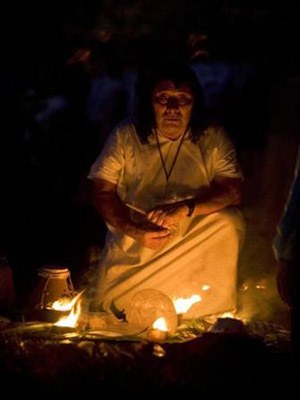 In the 1980s, when the Central American crystal skulls came to prominence, various atrocious crimes were committed against the Mayan population there. In countries like Guatemala, an oppressive regime slaughtered hundreds of thousands of Mayan people. It took years before the news of this “Silent Holocaust” became known; throughout the genocide, Western governments supported the Guatemalan government. Only able to rely on themselves, the Mayan people began to organise themselves – becoming terrorists or freedom fighters, depending on your perspective – and they began to use key dates from the Mayan calendar for their campaigns, hoping to shake the Mayan people awake and embrace their true origins and common heritage – one that transcended the modern borders Western world powers had created. Sociologists have labelled it the “Mayan Renaissance”. Today, three decades later, the world is very much aware of the Mayan calendar – especially its key date, December 21, 2012 – and millions of people visit the various Mayan monuments of Central America.
In the 1980s, when the Central American crystal skulls came to prominence, various atrocious crimes were committed against the Mayan population there. In countries like Guatemala, an oppressive regime slaughtered hundreds of thousands of Mayan people. It took years before the news of this “Silent Holocaust” became known; throughout the genocide, Western governments supported the Guatemalan government. Only able to rely on themselves, the Mayan people began to organise themselves – becoming terrorists or freedom fighters, depending on your perspective – and they began to use key dates from the Mayan calendar for their campaigns, hoping to shake the Mayan people awake and embrace their true origins and common heritage – one that transcended the modern borders Western world powers had created. Sociologists have labelled it the “Mayan Renaissance”. Today, three decades later, the world is very much aware of the Mayan calendar – especially its key date, December 21, 2012 – and millions of people visit the various Mayan monuments of Central America.
The 2010 World Cup in South Africa was seen as a joyous event for Africa, showing that Africa is not just a country of civil war and hunger. There is great joy in a continent that gave us the Ancient Egyptian civilisation, while Kenya is seen as the “cradle of Mankind”, for the remains of the earliest hominids have been found in that country. Twenty years ago, American bestselling author Kathleen McGowan attended a crystal skull workshop lead by Susan McCune. McGowan was told that in the future, she would work with skulls from Africa and that several skulls would emerge from that continent. When she saw Compassion in July 2010, McGowan remembered McCune’s prophecy. And if McCune is right, Compassion is but the first in a series of African skulls that will make their existence known the world. And with their emergence, will there be a renewed appreciation for the African continent?
At this moment in time, Compassion’s existence has already changed the entire crystal skull debate, showing that the Mitchell-Hedges skull is not unique in its complexity, and that Central America is unlikely to be the only origin of crystal skulls. The question as to the origins of the crystal skulls has therefore been redefined: did various ancient cultures have them? Did an African civilisation bring them to the American continent? Or do we need to delve further back in time, to a lost civilisation, like Atlantis, from which these skulls originated? A new dawn in crystal skull research has just broken…
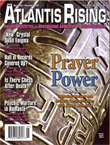
This article appeared in Atlantis Rising, Issue 84 (November - December 2010).
Thank you Phillip! RIP. Crystal Wind
Source Here
Liked this article? Dive deeper into personal growth and wellness! Check out CrystalWind.ca for spiritual wisdom or explore AromaWorx.ca for natural well-being tips. Spread the positivity—share this with friends on their happiness journey!
Let’s Chat! Drop Your Thoughts Below! ![]()
Dive into the Mystical World of the Crystal Wind Oracle Deck!
Get All the Enchanting Details Now!
NEW Expanded Boxed Edition!
Now with 58 Cards for Richer Wisdom!

Crystal Healing
Imagine a world of inspiration and healing, free for all—made possible by YOU!
Donate Now—Ignite the Magic at CrystalWind.ca!

Epilepsy - Finding A Cure
Your donation can make a difference!
Help us find a cure – donate now!
Crystals In Depth
Crystal Tools
Unlock Your Light: Join Lightworkers Worldwide on CrystalWind.ca!
Crystal Skulls
Follow Us!
Featured This Month
Ducks Fly Moon
Raven - Bloodstone Jasper - Mullein - Brown September 23 to October 23 The D... Read more
Black Tourmaline
The Negativity Remedy Stone Black Tourmaline (Schorl) is one of the best st... Read more
Autumn Equinox
The Autumn Equinox is a time of harvesting and preparation. It is a time to ... Read more
Mabon Magic: Ideas For Fall Decoration And R…
Welcome (almost!) to Fall! We’re turning the Great Wheel once again, toward ... Read more
Mabon in Modern Times: Fresh Takes on the Au…
The Mabon season begins somewhere around the 21st-22nd of September and cont... Read more
Libra’s Featured Stone - Kyanite
Kyanite Birthstone: Libra Planet: Venus Element: Air Chakra: Throat Read more

























































































































